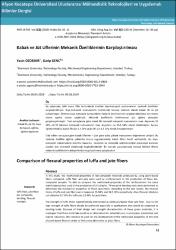| dc.contributor.author | Özdemir, Yasin | |
| dc.contributor.author | Genç, Garip | |
| dc.date.accessioned | 2021-07-02T06:34:00Z | |
| dc.date.available | 2021-07-02T06:34:00Z | |
| dc.date.issued | 2019 | en_US |
| dc.identifier.citation | Ozdemir, Y , Genc, G . (2019). Comparison of Flexural Properties of Luffa and Jute Fibers . Afyon Kocatepe Üniversitesi Uluslararası Mühendislik Teknolojileri ve Uygulamalı Bilimler Dergisi , 2 (2) , 61-65 | en_US |
| dc.identifier.issn | 2667-4165 | |
| dc.identifier.uri | https://dergipark.org.tr/tr/pub/akuumubd/issue/45622/559182 | |
| dc.identifier.uri | https://hdl.handle.net/11630/8738 | |
| dc.description.abstract | In this study, the mechanical properties of bio-composite materials produced by using plant-based
fibers compared. Luffa fiber and jute were used as reinforcement in the production of these biocomposite samples. To able to compare the mechanical properties of the reinforcement the same
matrix (epoxy) was used in the production of all samples. Three-point bending tests were performed to
determine the mechanical properties of these specimens. According to the test results, the Flexural
Stress of luffa and jute fibers were measured 55 MPa and 36.5 MPa respectively. Also, Flexural Modulus
calculated as 5.7 GPa for luffa and 5.5 GPa for jute fibers.
The strength of luffa fibers experimentally determined as obviously higher than jute fiber. Due to the
high strength of luffa fibers should be preferred especially in applications that would be subjected to
bending loads. Because of their design and strength characteristics of these green materials, it is
envisaged that these materials could be an alternative for potential uses in aerospace, automotive and
marine industries. We continue to work on the development of the mechanical properties of this kind
of plant-based fibers in order to find a new alternative to glass fibers. | en_US |
| dc.description.abstract | Bu çalışmada, bitki esaslı lifler kullanılarak üretilen biyo-kompozit malzemelerin mekanik özellikleri
karşılaştırılmıştır. Biyo-kompozit numunelerin üretiminde takviye elemanı olarak kabak lifi ve jüt
kullanılmıştır. Üretilen biyo-kompozit numunelerin mekanik özelliklerinin karşılaştırılabilmesi için matris
olarak epoksi reçine seçilmiştir. Mekanik özelliklerin belirlenmesi için eğilme deneyleri
gerçekleştirilmiştir. Test sonuçlarına göre kabak lifi takviyeli kompozit numunelerin max. dayanımı 55
MPa jüt lifi takviyeli kompozit numunelerin max. dayanımı ise 36.5 MPa olarak ölçülmüştür. Ayrıca,
Eğilme Modülü, kabak lifi için 5.7 GPa ve jüt lifi için 5.5 GPa olarak hesaplanmıştır.
Elde edilen sonuçlara göre kabak liflerinin – jüte göre daha yüksek mukavemet değerlerine sahiptir. Bu
nedenle özellikle eğilme yüklerine maruz uygulamalarda Kabak lifleri tercih edilmelidir. Bu biyokompozit malzemelerin özellikle havacılık, otomotiv ve denizcilik sektörlerindeki potansiyel kullanım
alanları için alternatif olabileceği öngörülmektedir. Bir sonraki çalışmamızda mevcut bitkisel liflerin
mekanik özelliklerinin iyileştirilmesi ve geliştirilmesi çalışılacaktır. | en_US |
| dc.language.iso | eng | en_US |
| dc.publisher | Afyon Kocatepe Üniversitesi | en_US |
| dc.rights | info:eu-repo/semantics/openAccess | en_US |
| dc.subject | Luffa Fiber | en_US |
| dc.subject | Bio-Composite | en_US |
| dc.subject | Bending | en_US |
| dc.subject | Flexural Strength | en_US |
| dc.subject | Jute Fiber | en_US |
| dc.title | Comparison of flexural properties of luffa and jute fibers | en_US |
| dc.title.alternative | Kabak ve jüt liflerinin mekanik özelliklerinin karşılaştırılması | en_US |
| dc.type | article | en_US |
| dc.relation.journal | Afyon Kocatepe Üniversitesi Uluslararası Mühendislik Teknolojileri ve Uygulamalı Bilimler Dergisi | en_US |
| dc.department | Fakülteler, Teknoloji Fakültesi, Makine Mühendisliği Bölümü | en_US |
| dc.authorid | 0000-0001-9274-1292 | en_US |
| dc.authorid | 0000-0001-7711-3845 | en_US |
| dc.identifier.volume | 2 | en_US |
| dc.identifier.startpage | 61 | en_US |
| dc.identifier.endpage | 65 | en_US |
| dc.identifier.issue | 2 | en_US |
| dc.relation.publicationcategory | Makale - Uluslararası Hakemli Dergi - Başka Kurum Yazarı | en_US |



















